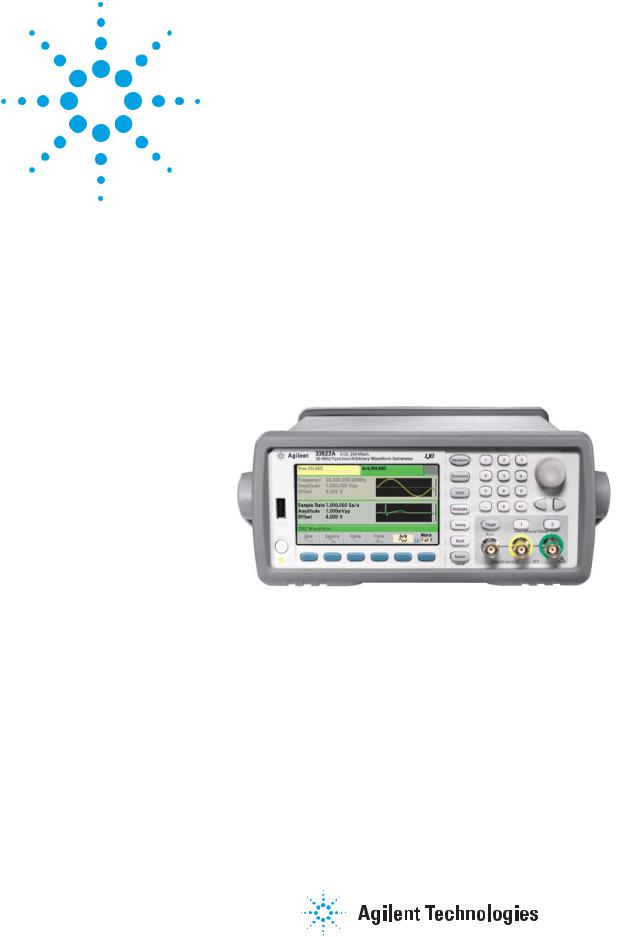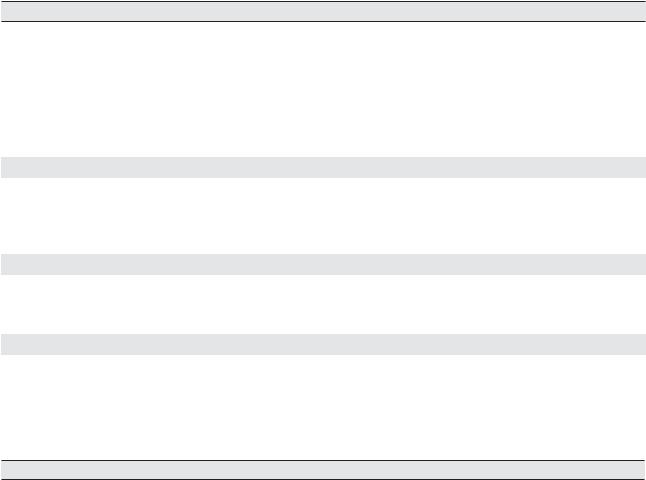Atec Agilent-33521A, Agilent-33522A User Manual

Agilent 30 MHz Function/Arbitrary
Waveform Generators
Data Sheet
33521A 1-Channel Function/Arbitrary Waveform Generator
33522A 2-Channel Function/Arbitrary Waveform Generator
Lowest jitter and total harmonic distortion in its class and true point-by-point arbitrary waveforms that are always alias-protected
for exceptional accuracy
Achieving a New Level of Accuracy and Flexibility
Everyday you’re developing new technologies that are faster, more efficient, smaller, greener and require more accuracy than ever before. Agilent 33500 Series function/ arbitrary waveform generators offer the highest signal fidelity and implement a new breakthrough technology
that provides you with the ability to generate more accurate arbitrary waveforms. With 10x better jitter than anything in their class, they offer unparalleled control of signal frequency for your most challenging measurements.
33500 Series Function/Arbitrary Waveform Generators
Key features
•30 MHz sine, square, and pulse bandwidth cover more applications
•< 40 ps jitter and less than .04% total harmonic distortion for more precise signals
•250 MSa/s, 16-bit sampling rate for higher time-resolution arbitrary waveforms
•True point-by-point arbitrary waveforms with sequencing
for more accurate representation of user-defined signals
•Dual-channel mode with independent or coupled channels
•1 MSa waveform memory standard, 16 MSa (optional) for more complicated arbitrary waveforms
•LXI Class C compliant
•Large, color, graphical display allows for simultaneous parameter setup and signal viewing/editing for intuitive operation
•Optional BenchLink Waveform Builder Pro software for custom user-defined waveforms
Signal fidelity
You depend upon the fidelity of generated signals to verify the development of your designs. The higher the fidelity of the generated signal, the more assurance the device under development will perform to your exacting standards. The 33500 Series function/arbitrary waveform generators have < 40 ps jitter for any signal ― ten times better than existing function/arbitrary waveform generators. They provide 16-bit resolution, which is the highest resolution in their class. Combined with less than .04% total harmonic distortion and 250 MSa/s, 16-bit sampling, optional high-stability timebase and optional arbitrary waveform memory expansion, you now have access to an affordable new family of generators with unparallel signal fidelity.
Flexible signal generation
The 33521A and 33522A have the ability to create two-tone signals for dual-tone multi-frequency (DTMF) signal applications used in telecommunication device test.
A feature specific to the 33522A generator is a flexible, dual-channel mode with frequency and amplitude coupling, differential channels, and combined output channels. This functionality is useful in applications where testing a device, such as a pacemaker, relies on the timing and interaction of two distinct signals to operate properly.
Point-by-point waveforms
The 33500 Series expands your signaling capability with true point- by-point arbitrary waveforms that are always alias-protected for exceptional accuracy. The 33521A and 33522A are first in their class to generate
30 MHz signals, including common waveforms, arbitrary waveforms and sophisticated modulated waveforms. Both models leverage proprietary technology to provide you with
unprecedented input control when defining arbitrary waveforms. That control equates to the ability to define more complex point-by-point waveforms with sequencing.
User interface
A large, color, graphical display offers simultaneous parameter setup, signal viewing, and editing for easy operation. The 33500 Series is fully compliant with the LXI Class C specifications and offers USB 2.0 and 10/100 Base-T Ethernet connectivity for quick and easy connectivity to a PC or network. The 33500 Series also supports remote operation using a browser to connect to a built-in Web page. GPIB is offered as an optional interface.
Optional 33503A BenchLink Waveform Builder Pro Softrware
Benchlink Waveform Builder Pro is ideal for R&D engineers characterizing new designs and test system engineers validating production units. The software is a Microsoft Windows®-based program that provides easy-to-use creation tools, such as an equation editor, waveform math and drawing tools, which can be used to create custom signals. It features a standard function library, waveform sequencer, and filters and; as well as windowing functions that allow you to easily modify and further refine your waveform. A library of built-in signals supports fast creation of more complex waveforms.
With BenchLink Waveform Builder Pro, you gain access to advanced signal creation and editing capabilities, without requiring hours of programming. The result is quicker, easier creation of custom waveforms, coupled with deeper analysis insight into your signals.
For additional information and to download a 30-day trial version of the software, visit: www.agilent.com/find/33503
2

Specifications
Unless otherwise stated, all specifications apply with a 50 Ω resistive load and auto range ON.
Instrument characteristics
Models & options
33521A |
1-channel |
33522A |
2-channel |
Option 002 |
Increases arbitrary waveform memory to 16 MSa/channel |
Option 010 |
OCXO timebase for ultra-high stability |
Option 400 |
GPIB interface |
Waveforms |
|
Standard |
Sine, square, ramp, pulse, triangle, Gaussian noise, |
|
PRBS (Pseudorandom Binary Sequence), DC |
Built-in arbitrary |
Cardiac, exponential fall, exponential rise, Gaussian pulse, |
|
Haversine, Lorentz, D-Lorentz, negative ramp, sinc |
User-defined arbitrary |
Up to 1 MSa (16 MSa with Option 002) with multi-segment sequencing |
Operating modes & modulation types |
|
Operating modes |
Continuous, modulate, frequency sweep, burst, output gate |
Modulation types |
AM, FM, PM, FSK, BPSK, PWM, Sum (carrier + modulation) |
Waveform characteristics
Sine
Frequency range |
1 µHz to 30 MHz, 1-µHz resolution |
|
Amplitude flatness (spec)1, 2 |
< 100 kHz: |
± 0.10 dB |
(relative to 1 kHz) |
100 kHz to 5 MHz: |
± 0.15 dB |
|
5 to 20 MHz: |
± 0.30 dB |
|
20 to 30 MHz: |
± 0.40 dB |
Harmonic distortion (typ) 2, 3 |
< 20 kHz: |
< -70 dBc |
|
|
20 to |
100 kHz: |
< -65 dBc |
|
100 kHz to 1 MHz: |
< -50 dBc |
|
|
1 to 20 MHz: |
< -40 dBc |
|
|
20 to |
30 MHz: |
< -35 dBc |
THD (typ) |
20 Hz to 20 kHz: |
< 0.04% |
Non-harmonic spurious (typ) 2, 3 |
Standard: < -75 dBc, increasing +20 dB/decade above 2 MHz |
|
|
Option 010: < -75 dBc, increasing +20 dB/decade above 10 MHz |
|
|
(or < -100 dBm, whichever is greater, below 500 MHz) |
|
Phase noise (SSB) (typ) |
Standard |
Option 010 |
1 kHz offset: |
-105 |
-110 dBc/Hz |
10 kHz offset: |
-115 |
-125 dBc/Hz |
100 kHz offset: |
-125 |
- 135 dBc/Hz |
3

Waveform characteristics, continued
Square & pulse
Frequency range |
1 µHz to 30 MHz, 1 µHz resolution |
Rise and fall times (nom) |
Square: 8.4 ns, fixed |
|
Pulse: 8.4 ns to 1 µs, independently variable, 100-ps or 3-digit resolution |
Overshoot (typ) |
< 2% |
Duty cycle |
0.01% to 99.99% 8 |
Pulse width |
16 ns minimum, 100-ps resolution |
Jitter (cycle-to-cycle, typ) |
< 40 ps rms |
Ramp & triangle |
|
Frequency range |
1 µHz to 200 kHz, 1 µHz resolution |
Ramp symmetry |
0.0% to 100.0%, 0.1% resolution |
|
(0% is negative ramp, 100% is positive ramp, 50% is Triangle) |
Nonlinearity (typ) |
< 0.05% from 5% to 95% of the signal amplitude |
Gaussian noise |
|
Bandwidth (typ) |
1 mHz to 30 MHz, variable |
Crest factor (nom) |
4.6 |
Repetition period |
> 50 years |
Pseudorandom binary sequence (PRBS) |
|
Bit rate |
1 mbps to 50 Mbps, 1 mbps resolution |
Sequence length |
2m -1, m=7, 9, 11, 15, 20, 23 |
Rise and fall times (nom) |
8.4 ns to 1 µs, variable, 100-ps or 3-digit resolution |
Arbitrary waveform characteristics
General
Waveform length |
8 Sa to 1 MSa (16 MSa with Option 002) in increments of 1 sample |
|
Sample rate |
1 µSa/s to 250 MSa/s, 1 µSa/s resolution |
|
Voltage resolution |
16 bits |
|
Bandwidth (-3 dB, nom) |
Filter Off: |
40 MHz |
|
“Normal” Filter On: 0.27 x (Sample Rate) |
|
|
“Step” Filter On: 0.13 x (Sample Rate) |
|
Rise and fall time |
0.35 / Bandwidth (10 ns min) with "Normal" or "Step" filter On |
|
Settling time (typ) |
< 200 ns to 0.5% of final value |
|
Jitter (typ) |
Filter Off: |
< 40 ps rms |
|
“Normal” or “Step” filter On: < 5 ps |
|
4
